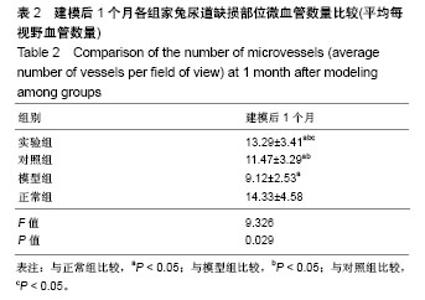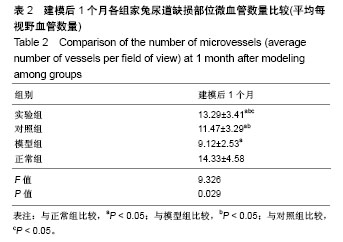| [1] 杜小文,陈浩浩,刘庆,等.内纵外螺旋双层结构管状尿道支架复合体修复尿道缺损的可行性及其血管化方法[J].中华泌尿外科杂志, 2017,38(1):59-65.[2] 徐秀娟,陈恕柱,吴旻,等.保留尿道板尿道下裂修复术后并发症危险因素分析[J].中华男科学杂志,2017,23(4):347-352.[3] Wang DJ,Li MY,Huang WT,et al.Repair of urethral defects with polylactid acid fibrous membrane seeded with adipose-derived stem cells in a rabbit model.Connect Tissue Res. 2015;56(6): 434-439. [4] 陈刚,白建华,朱新锋,等.脱细胞真皮基质修复猪胆管缺损:促进血管及胆管上皮再生[J].中国组织工程研究, 2015,19(43):6940-6945.[5] Fu Q,Zhang YM,Barbagli G,et al.Factors that influence the outcome of open urethroplasty for pelvis fracture urethral defect (PFUD): an observational study from a single high-volume tertiary care center.World J Urol.2015;33(12):2169-2175. [6] 王忠新,李钢,洪宝发,等.新型药物缓释尿道支架修复创伤性尿道狭窄[J].中华创伤杂志,2015,31(7):660-663.[7] Hunter C,Shahrour W,Joshi P,et al.V12-02 pedicle preputial tube for pelvic fracture urethral defect and ischemic bulbar urethra.J Urol.2015;193(4):e977-e977.[8] 唐勇,李养群,赵穆欣,等.口腔黏膜卷管游离移植一次性重建远段尿道[J].中华整形外科杂志,2017,33(1):34-36.[9] Kulkarni SB,Shahrour W,Joshi P,et al.V12-01 laparoscopic omentoplasty to support anastomotic urethroplasty in complex and redo pelvic fracture urethral defect patients.J Urol. 2015; 193(4):e977-e977.[10] 徐月敏,谢弘,吕向国,等.膀胱壁瓣重建新尿道治疗女性全尿道狭窄或缺如的疗效[J].中华泌尿外科杂志,2016,37(8):603-606.[11] 林海,王玉芸,林国雄,等.带蒂睾丸鞘膜瓣覆盖技术在复发性尿道皮肤瘘修复中的应用[J].中华泌尿外科杂志, 2016,37(4):289-291.[12] Montgomery B,Husmann D.PD44-07 pelvic fracture urethral distraction defect (pfudd) with associated rectal injury: a review of acute and definitive urologic management with long term outcomes. J Urol.2016;195(4):e1000.[13] 梁锋,章一新,陈昴.腹壁下动脉穿支皮瓣修复外阴癌根治术后创面的方法及效果[J].中国临床解剖学杂志,2016,34(1):33-35.[14] D'Este M,Sprecher CM,Milz S,et al.Evaluation of an injectable thermoresponsive hyaluronan hydrogel in a rabbit osteochondral defect model.J Biomed Mater Res A. 2016;104(6):1469-1478.[15] 杨世辉,孙维国,李永乐,等.右美托咪定用于骶管阻滞在小儿尿道下裂修复术后加速康复中的作用[J].广东医学, 2017,38(16): 2537-2539.[16] Kulkarni SB,Barbagli G,Joshi PM,et al.Laparoscopic omentoplasty to support anastomotic urethroplasty in complex and redo pelvic fracture urethral defects.Urology.2015;85(5):1200-1205.[17] 吕军,温海东,彭天洲,等.镶嵌式唇黏膜和膀胱黏膜修复复杂性尿道皮肤瘘的临床疗效分析[J].中华男科学杂志, 2016,22(7):621-625.[18] 唐耘熳,王学军,毛宇,等.横行带蒂岛状包皮瓣尿道成形造瘘术分期矫治尿道下裂[J].中国修复重建外科杂志,2016,9(5):594-598.[19] 徐月敏,撒应龙,傅强,等.舌黏膜背侧替代一期尿道成形术治疗修复失败的尿道下裂患者的疗效[J].中华泌尿外科杂志, 2015,36(3): 217-220.[20] Chen G,Yang L,Lv Y.Cell-free scaffolds with different stiffness but same microstructure promote bone regeneration in rabbit large bone defect model.J Biomed Mater Res A. 2016;104(4):833-841. [21] 范志强,刘中华,皇甫雪军,等.皮瓣法重建阴茎段尿道在重度尿道下裂分期手术中的应用[J].中华整形外科杂志, 2015,31(6):414-418.[22] 张志勇,于光屹,陶丹丹,等.应用骨髓间充质干细胞复合关节软骨脱细胞基质修复兔软骨缺损的实验研究[J].中国医药指南, 2017, 15(22):53-54.[23] [Omlor GW,Kleinschmidt K,Gantz S,et al.Increased bone formation in a rabbit long-bone defect model after single local and single systemic application of erythropoietin.Acta Orthop. 2016; 87(4):425.[24] 杜昆峰.脂肪干细胞联合血管内皮细胞修复兔尿道缺损的实验研究[D].郑州大学,2016.[25] 舒雄,郑蕊,杰永生,等.脂肪干细胞复合真皮脱细胞基质修复兔关节软骨缺损的实验研究[J].中国医药生物技术, 2017,12(2):143-148. |





